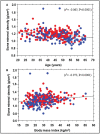Association of bone mineral density with prediabetes risk among African-American and European-American adult offspring of parents with type 2 diabetes
- PMID: 36686435
- PMCID: PMC9849381
- DOI: 10.3389/fendo.2022.1065527
Association of bone mineral density with prediabetes risk among African-American and European-American adult offspring of parents with type 2 diabetes
Abstract
Introduction: Type 2 diabetes mellitus (T2DM) is associated with alterations in bone mineral density (BMD), but association between prediabetes and BMD is unclear.
Methods: We analyzed BMD among the initially normoglycemic participants in the Pathobiology of Prediabetes in a Biracial Cohort (POP-ABC) study in relation to incident prediabetes during 5 years of follow-up.
Results and discussion: A total of 343 participants (193 Black, 150 White) underwent DEXA during Year 1 of POP-ABC and were followed quarterly for 5 years. The mean age was 44.2 ± 10.6 years; BMI was 30.2 ± 7.23 kg/m2. At baseline, the mean BMD was 1.176 ± 0.135 g/cm2 (1.230 ± 0.124 g/cm2 in men vs. 1.154 ± 0.134 g/cm2 in women, P<0.0001; 1.203 ± 0.114 g/cm2 in Black vs. 1.146 ± 0.150 g/cm2 in White participants, P=0.0003). During 5 years of follow-up, 101 participants developed prediabetes and 10 subjects developed T2DM (progressors); 232 were nonprogressors. Progressors to prediabetes had numerically higher baseline BMD and experienced lower 1-year decline in BMD (P<0.0001) compared with nonprogressors. From Kaplan-Meier analysis, the time to 50% prediabetes survival was 2.15 y among participants in the lowest quartile of baseline BMD, longer than those in higher quartiles (1.31 - 1.41 y). Values for BMD correlated inversely with age and adiponectin levels, and positively with BMI. In logistic regression analysis, BMD z score significantly predicted incident prediabetes: more negative BMD z scores were associated with decreased incident prediabetes (odds ratio 0.598 [95% confidence interval 0.407 - 0.877], P=0.0085), after controlling for age, BMI, change in BMI, ethnicity, blood glucose and adiponectin.
Conclusions: Among initially normoglycemic individuals, higher baseline BMD was associated with higher risk of incident prediabetes during 5 years of follow-up.
Keywords: bone mineral density; impaired fasting glucose; impaired glucose tolerance; prospective study; race/ethnicity.
Copyright © 2023 Liu, Asuzu, Patel, Wan and Dagogo-Jack.
Conflict of interest statement
The authors declare that the research was conducted in the absence of any commercial or financial relationships that could be construed as a potential conflict of interest.
Figures



Similar articles
-
Dietary habits and leisure-time physical activity in relation to adiposity, dyslipidemia, and incident dysglycemia in the pathobiology of prediabetes in a biracial cohort study.Metabolism. 2015 Sep;64(9):1060-7. doi: 10.1016/j.metabol.2015.05.015. Epub 2015 Jun 6. Metabolism. 2015. PMID: 26116207 Free PMC article.
-
Relationships between blood pressure and blood glucose among offspring of parents with type 2 diabetes: Prediction of incident dysglycemia in a biracial cohort.J Diabetes Complications. 2017 Nov;31(11):1580-1586. doi: 10.1016/j.jdiacomp.2017.07.019. Epub 2017 Aug 2. J Diabetes Complications. 2017. PMID: 28890305
-
Adiponectin levels predict prediabetes risk: the Pathobiology of Prediabetes in A Biracial Cohort (POP-ABC) study.BMJ Open Diabetes Res Care. 2016 Mar 17;4(1):e000194. doi: 10.1136/bmjdrc-2016-000194. eCollection 2016. BMJ Open Diabetes Res Care. 2016. PMID: 27026810 Free PMC article.
-
Insulin secretion, sensitivity, and clearance in normoglycemic Black and White adults with parental type 2 diabetes: association with incident dysglycemia.BMJ Open Diabetes Res Care. 2024 Dec 23;12(6):e004545. doi: 10.1136/bmjdrc-2024-004545. BMJ Open Diabetes Res Care. 2024. PMID: 39719314 Free PMC article.
-
Prediabetes and skeletal health.Curr Opin Endocrinol Diabetes Obes. 2023 Aug 1;30(4):200-205. doi: 10.1097/MED.0000000000000812. Epub 2023 May 29. Curr Opin Endocrinol Diabetes Obes. 2023. PMID: 37248797 Review.
Cited by
-
Exploring the link between osteosarcopenia and osteoarthritis in prediabetic adults using NHANES data.Sci Rep. 2025 Jun 5;15(1):19747. doi: 10.1038/s41598-025-95344-9. Sci Rep. 2025. PMID: 40473765 Free PMC article.
References
-
- Eller-Vainicher C, Zhukouskaya VV, Tolkachev YV, Koritko SS, Cairoli E, Grossi E, et al. . Low bone mineral density and its predictors in type 1 diabetic patients evaluated by the classic statistics and artificial neural network analysis. Diabetes Care (2011) 34(10):2186–91. doi: 10.2337/dc11-0764 - DOI - PMC - PubMed
Publication types
MeSH terms
Substances
Grants and funding
LinkOut - more resources
Full Text Sources
Medical

